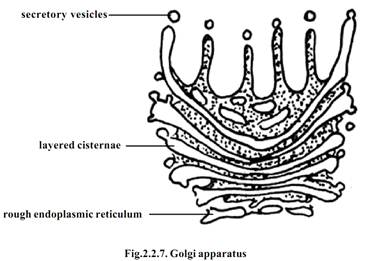


 النبات
النبات
 الحيوان
الحيوان
 الأحياء المجهرية
الأحياء المجهرية
 علم الأمراض
علم الأمراض
 التقانة الإحيائية
التقانة الإحيائية
 التقنية الحيوية المكروبية
التقنية الحيوية المكروبية
 التقنية الحياتية النانوية
التقنية الحياتية النانوية
 علم الأجنة
علم الأجنة
 الأحياء الجزيئي
الأحياء الجزيئي
 علم وظائف الأعضاء
علم وظائف الأعضاء
 الغدد
الغدد
 المضادات الحيوية
المضادات الحيوية|
Read More
Date: 4-11-2015
Date: 4-11-2015
Date:
|
Golgi apparatus
The Golgi apparatus was discovered by an Italian neurologist, Camillo Golgi in 1873.
The Golgi apparatus occurs in almost all animal cells except red blood cells. Animal cells usually have a single Golgi apparatus. Some cells have more of Golgi apparatus.
In most of the ectodermal and endodermal cells it occurs in between the nucleus and the periphery. In nerve cells it occupies a circum-nuclear position.
The simplest unit of the Golgi apparatus is the cisterna. A cisterna is about 1 µm in diameter. It has a membrane bound space. This space accumulates secretions. Numerous such cisternae are associated with each other and appear in a lamellar arrangement. In the lamellar arrangement the space between each cisterna is 20-30 nm. A group of these cisternae is called the dictyosome. A group of dictyosomes constitute the Golgi apparatus.

Typically a Golgi apparatus appears as a complex arrangement of interconnecting tubules, vesicles and cisternae.
The Golgi apparatus is the site of synthesis of biochemical. They also collect proteins and lipids made in the ER and add additional substances.
References
T. Sargunam Stephen, Biology (Zoology). First Edition – 2005, Government of Tamilnadu.



|
|
|
|
دراسة يابانية لتقليل مخاطر أمراض المواليد منخفضي الوزن
|
|
|
|
|
|
|
اكتشاف أكبر مرجان في العالم قبالة سواحل جزر سليمان
|
|
|
|
|
|
|
اتحاد كليات الطب الملكية البريطانية يشيد بالمستوى العلمي لطلبة جامعة العميد وبيئتها التعليمية
|
|
|